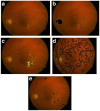Automated diagnosis of diabetic retinopathy and glaucoma using fundus and OCT images
- PMID: 22695250
- PMCID: PMC3477058
- DOI: 10.1186/1476-511X-11-73
Automated diagnosis of diabetic retinopathy and glaucoma using fundus and OCT images
Abstract
We describe a system for the automated diagnosis of diabetic retinopathy and glaucoma using fundus and optical coherence tomography (OCT) images. Automatic screening will help the doctors to quickly identify the condition of the patient in a more accurate way. The macular abnormalities caused due to diabetic retinopathy can be detected by applying morphological operations, filters and thresholds on the fundus images of the patient. Early detection of glaucoma is done by estimating the Retinal Nerve Fiber Layer (RNFL) thickness from the OCT images of the patient. The RNFL thickness estimation involves the use of active contours based deformable snake algorithm for segmentation of the anterior and posterior boundaries of the retinal nerve fiber layer. The algorithm was tested on a set of 89 fundus images of which 85 were found to have at least mild retinopathy and OCT images of 31 patients out of which 13 were found to be glaucomatous. The accuracy for optical disk detection is found to be 97.75%. The proposed system therefore is accurate, reliable and robust and can be realized.
Figures











Similar articles
-
Glaucoma Diagnostic Ability of the Optical Coherence Tomography Angiography Vessel Density Parameters.Curr Eye Res. 2017 Nov;42(11):1458-1467. doi: 10.1080/02713683.2017.1337157. Epub 2017 Sep 14. Curr Eye Res. 2017. PMID: 28910159
-
Peripapillary Retinal Nerve Fiber Layer Vascular Microcirculation in Glaucoma Using Optical Coherence Tomography-Based Microangiography.Invest Ophthalmol Vis Sci. 2016 Jul 1;57(9):OCT475-85. doi: 10.1167/iovs.15-18909. Invest Ophthalmol Vis Sci. 2016. PMID: 27442341 Free PMC article.
-
Optical coherence tomography angiography analysis of retinal vascular plexuses and choriocapillaris in patients with type 1 diabetes without diabetic retinopathy.Acta Diabetol. 2017 Jul;54(7):695-702. doi: 10.1007/s00592-017-0996-8. Epub 2017 May 5. Acta Diabetol. 2017. PMID: 28474119
-
Application of different imaging modalities for diagnosis of Diabetic Macular Edema: A review.Comput Biol Med. 2015 Nov 1;66:295-315. doi: 10.1016/j.compbiomed.2015.09.012. Epub 2015 Sep 25. Comput Biol Med. 2015. PMID: 26453760 Review.
-
Optical coherence tomography findings in diabetic retinopathy.Dev Ophthalmol. 2007;39:31-47. doi: 10.1159/000098498. Dev Ophthalmol. 2007. PMID: 17245077 Review.
Cited by
-
A convolutional neural network for the screening and staging of diabetic retinopathy.PLoS One. 2020 Jun 22;15(6):e0233514. doi: 10.1371/journal.pone.0233514. eCollection 2020. PLoS One. 2020. PMID: 32569310 Free PMC article.
-
Reliable feature selection for automated angle closure glaucoma mechanism detection.J Med Syst. 2015 Mar;39(3):21. doi: 10.1007/s10916-015-0199-1. Epub 2015 Feb 8. J Med Syst. 2015. PMID: 25663482
-
An automated detection of glaucoma using histogram features.Int J Ophthalmol. 2015 Feb 18;8(1):194-200. doi: 10.3980/j.issn.2222-3959.2015.01.33. eCollection 2015. Int J Ophthalmol. 2015. PMID: 25709931 Free PMC article.
-
Performance evaluation of various deep learning based models for effective glaucoma evaluation using optical coherence tomography images.Multimed Tools Appl. 2022;81(19):27737-27781. doi: 10.1007/s11042-022-12826-y. Epub 2022 Mar 28. Multimed Tools Appl. 2022. PMID: 35368855 Free PMC article.
-
Novel Deep Learning Model for Glaucoma Detection Using Fusion of Fundus and Optical Coherence Tomography Images.Sensors (Basel). 2025 Jul 11;25(14):4337. doi: 10.3390/s25144337. Sensors (Basel). 2025. PMID: 40732464 Free PMC article.
References
-
- Day C. The rising tide of type 2 diabetes. Br J Diabetes Vasc Dis. 2001;1:37–43. doi: 10.1177/14746514010010010601. - DOI
-
- Thomas RL, Dunstan F, Luzio SD, Roy Chowdury S, Hale SL, North RV, Gibbins RL, Owens DR. Incidence of diabetic retinopathy in people with type 2 diabetes mellitus attending the diabetic retinopathy screening service for Wales: retrospective analysis. BMJ. 2012;344:e874. doi: 10.1136/bmj.e874. - DOI - PMC - PubMed
-
- Fox CS, Pencina MJ, Meigs JB, Vasan RS, Levitzky YS, D’Agostino RB. Trends in the incidence of type 2 diabetes mellitus from the 1970s to the 1990s. The Framingham Heart Study. Circulation. 2006;113:2814–2918. - PubMed
MeSH terms
LinkOut - more resources
Full Text Sources
Other Literature Sources
Medical

